Magnificence of Maharajah Ranjit Singh at the Magnificent Wallace House
As the Independence Day of India approaches on the15th of August one goes on a memory jog to the numerous struggles for independence since the year 1757 and firm setting-in of British rule in India. Maharajah Ranjit Singh was a brave-heart who commenced the process of unification between the years 1799- 1839, raising a formidable, authoritative trained army against the Muslim Afghan rulers and the East India Company.
Maharajah Ranjit Singh – from India to England
The opulent magnificent Wallace House in Central London is an appropriate destination to exhibit the dazzling magnificence of the life and times of the renowned fearless warrior Maharajah Ranjit Singh offering multiple narratives in the moments spent there. The exhibition presents an exhaustive set of glittering expensive metal and stone studded battle weapons and armours, exquisite miniature paintings depicting diverse metaphors of the royal court and luminaries of the era, focusing on Maharajah Ranjit Singh himself.
At the exhibition Ranjit Singh – Sikh. Warrior. King ; one traverses eras to step into the 18th century Sikh empire spread over the vast regions of Punjab that are now parts of India & Pakistan. It explains the journey of Sikhs (the learners) from non-violent disciples of transcendent divine Guru Nanak to being obligated to militarize owing to tyrannies of Mughalscenturies later!
The Impressive Entrance- Stepping into the 18th century
The impressive exhibition entrance is a large canvas that partially portrays artist Bishan Singh’s huge painting from 1863-64 – an aerial view of Maharajah Ranjit Singh’s Royal court in the forefront and open fields dotted with trees in the far background!
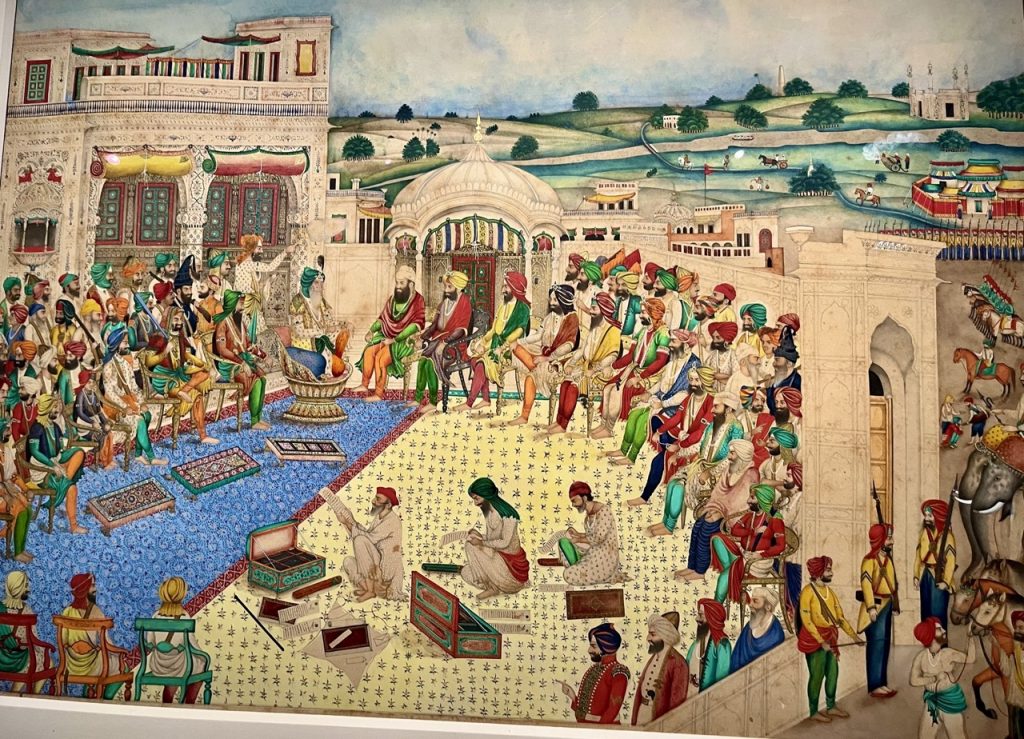
The Lahore Royal court of Maharajah Ranjeet Singh- impressive Gouache painting with gold & silver by artist Bishan Singh 1863-64
A palace fort domed entrance-painting whose every fragment has a story to tell as every canvas evokes dialogue; old tales retold in colour. The kaleidoscopic colours of the turban, the traditional Sikh attire, the details of the elegant jewellery, the carpet design- each is inimitable like a photograph taken with a camera!
Regal Maroon Interiors- Expensive Weapons and more
One is unprepared for the regal maroon interiors of the galleries where each and every exhibit is displayed with a background of exquisite jaali work. The first is the18th-19th century Shamshir or glittering Sword of Maharajah Ranjit Singh engraved with his Tiger emblem which is comprised of watered steel, gold, copper, walrus ivory, pearl & onyx whereas the cover is made of gold, wood, leather, rubies, pearls, paste and metal thread.
The unique Turban Helmet( Taup) of Maharajah Ranjit Singh; to adjust the Sikh Turban, made of Steel gold, brass & velvet!
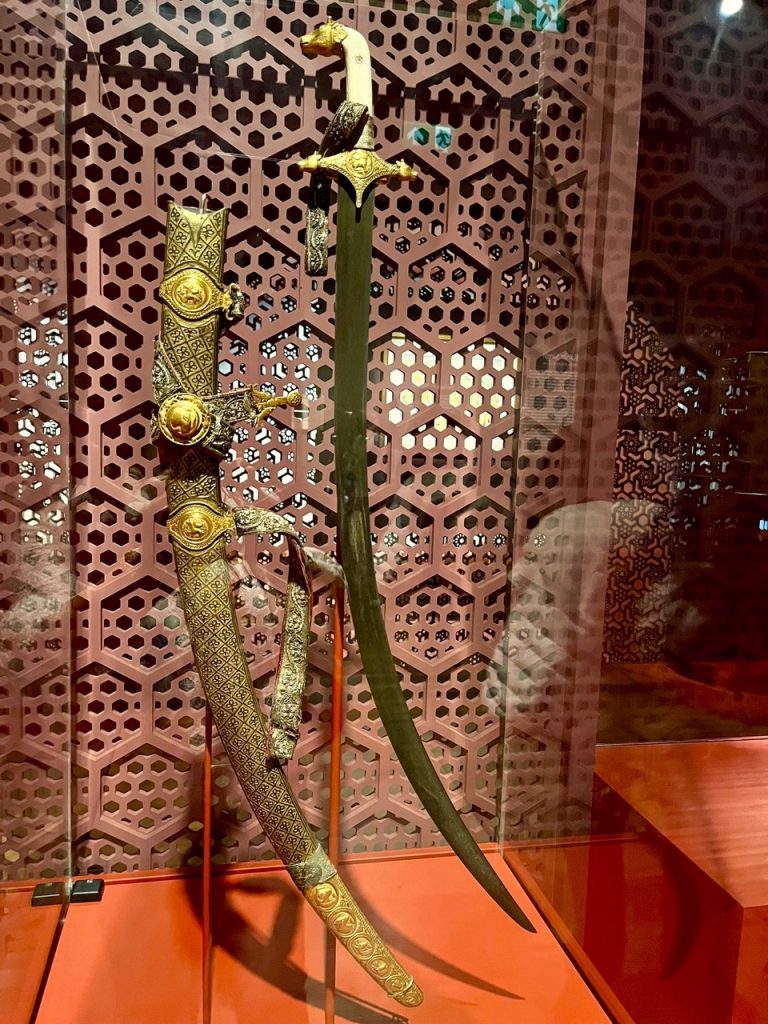
The magnificent Shamshir- the Tiger emblem sword of Maharajah Ranjeet Singh made of steel, gold copper, walrus ivory alonwith a cover of wood
One marvels at the Cuirass or Armour Breast plate- a mixture of steel, iron, gold copper brass and velvet that bears a gold portrait of Guru Nanak in the centre etched with Gurmukhi scriptures around to protect from death and wishing success in the battlefield!
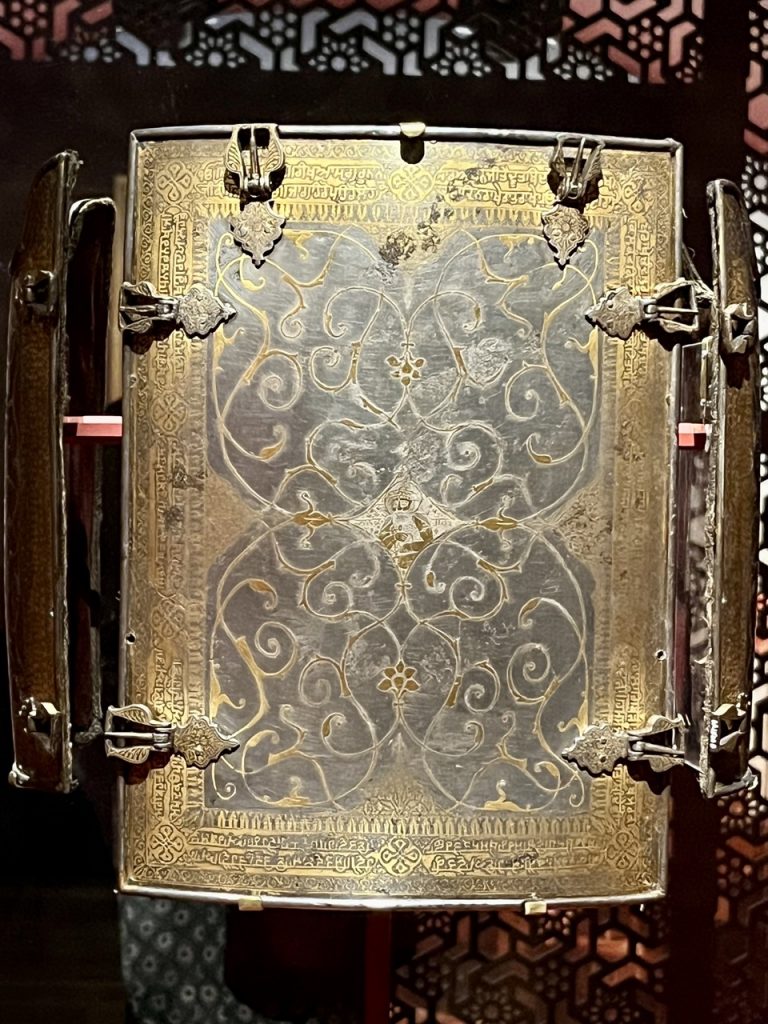
Cuirass or Armour Breast plate-that bears a gold portrait of Guru Nanak in the centre etched with Gurmukhi scriptures for success & protection
Next comes the metal Vambraces- armour for the arms again made with steel & golden quilted velvet sown with sequins & silver thread!
Next comes a Taup or special Sikh turban helmet for the warriors again made of steel, iron, gold & brass.
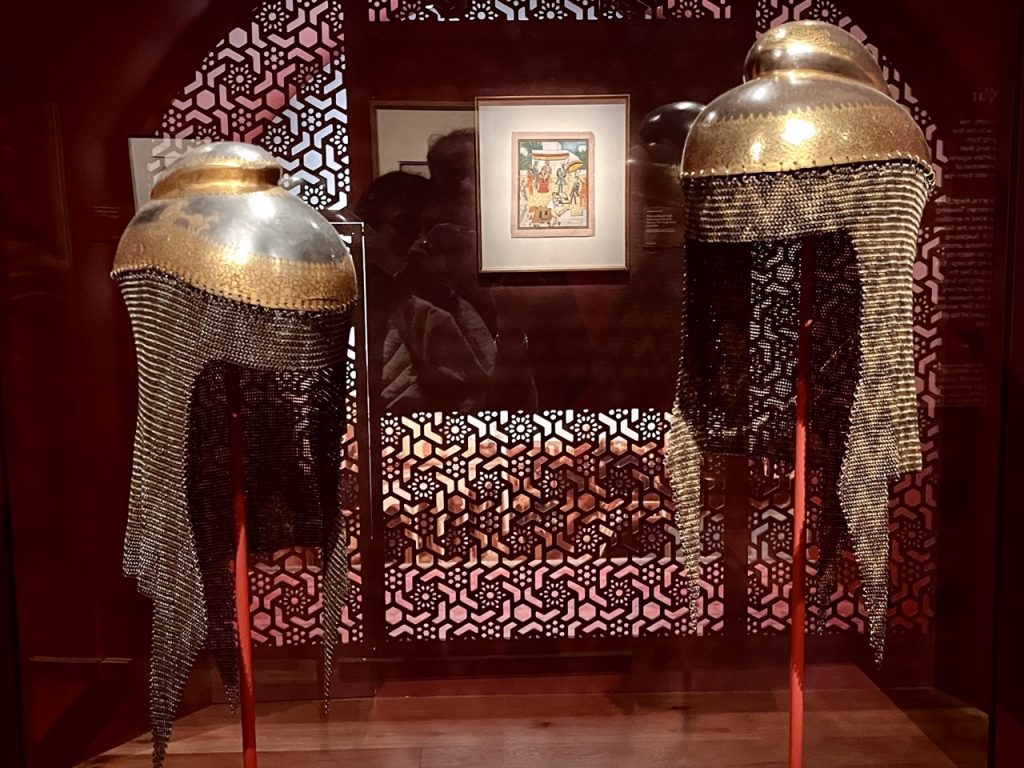
The unique Turban Helmet( Taup) of Maharajah Ranjit Singh; to adjust the Sikh Turban, made of Steel gold, brass & velvet!
Past more extraordinary battle weapons of Maharajah Ranjit Singh– Flintlock pistol, sword, bow, Matchlock musket and belt with ammunition pouches, one can pause at the Maharajah’s Pahari-Rajasthani style miniature painting with his daunting aide- Hari Singh Nalwa, exhibited with his gem-studded Shield of steel & gold!
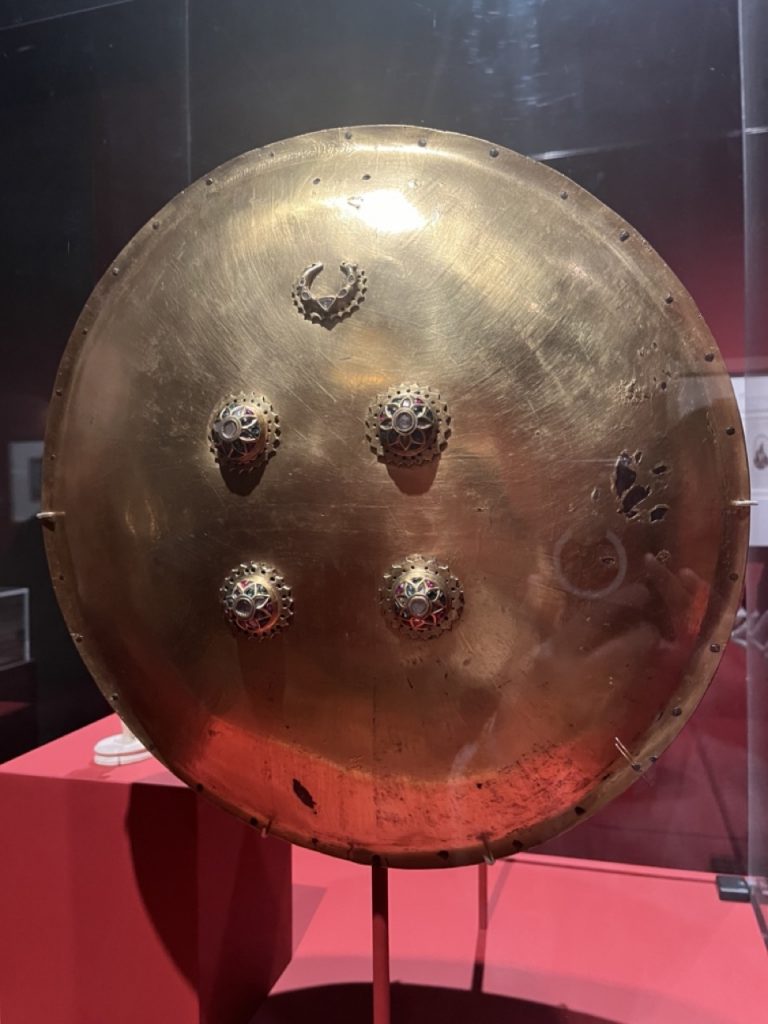
Gold & steel gem-studded Shield of formidable warrior of Maharajah Ranjit Singh ji- Hari Singh Nalwa 1824
The Entrance Painting Again & the Golden Lotus Throne
Viewing the next painting one recalls that this is artist Bishan Singh’s same painting that is displayed at the Exhibition entrance but a complete canvas here -the superlative Lahore fort royal court, Gouache painting on paper highlighted with gold and silver. A closer look reveals the Maharajah on his golden throne encircled by princes, heirs, ministers and royal courtiers in their finery- a timeless cultural representation of bygone era!
One cannot miss stopping by to admire the glorious completely & delicately embossed Golden Throne made by goldsmith Hafiz Muhammad in shape of the lotus flower and transported to India museum in Britain by the East India Company, after annexation of Punjab in 1849!!
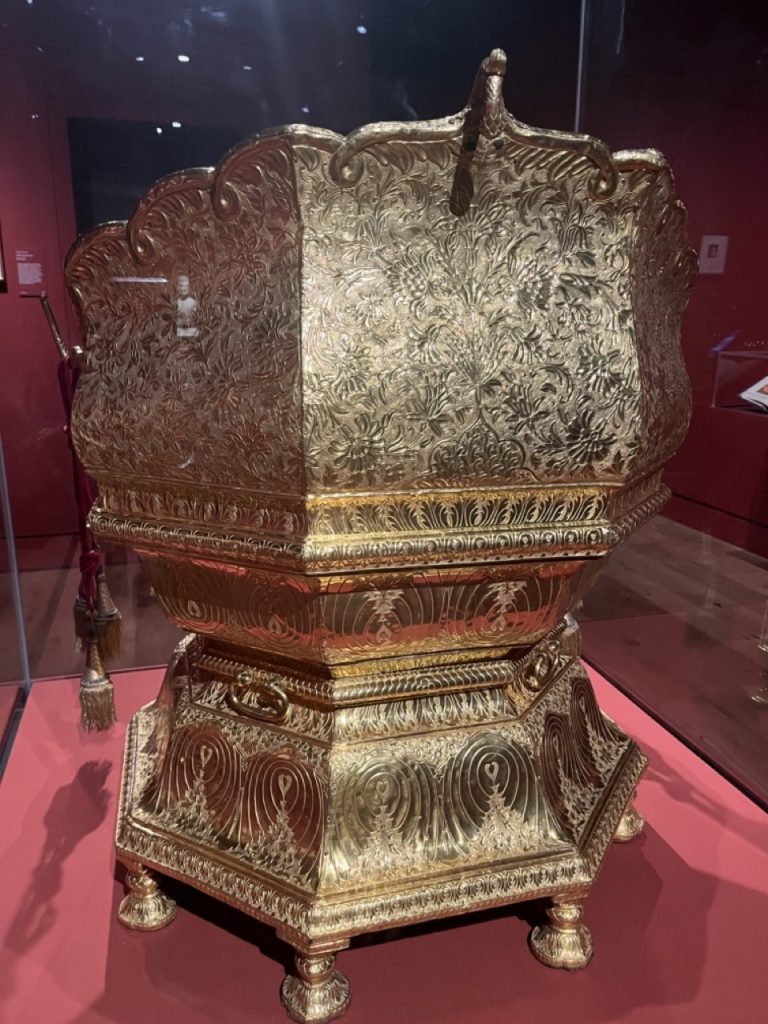
The finely embossed sheets of gold ornamentation by Hafiz Muhammad Multani ,1820-30 on the Golden Throne of Maharajah Ranjit Singh ji
Maharani Jind Kaur
Next to the sketch of the ill-fated queen Maharani Jind Kaur are numerous expensive classy jewellery pieces of gold, diamond emeralds rubies and seed pearls.

Pencil sketch of Maharani Jind Kaur 1863-mother Duleep Singh, proclaimed as Maharajah at the age of 5 but never was to be one!
Ironically, from her personal collection of about 1000 jewellery pieces only 600 were returned to her following tumultuous circumstances for years. They were retailed by Frazer & Haws from Regent Street, after her death in the Kensington home!!
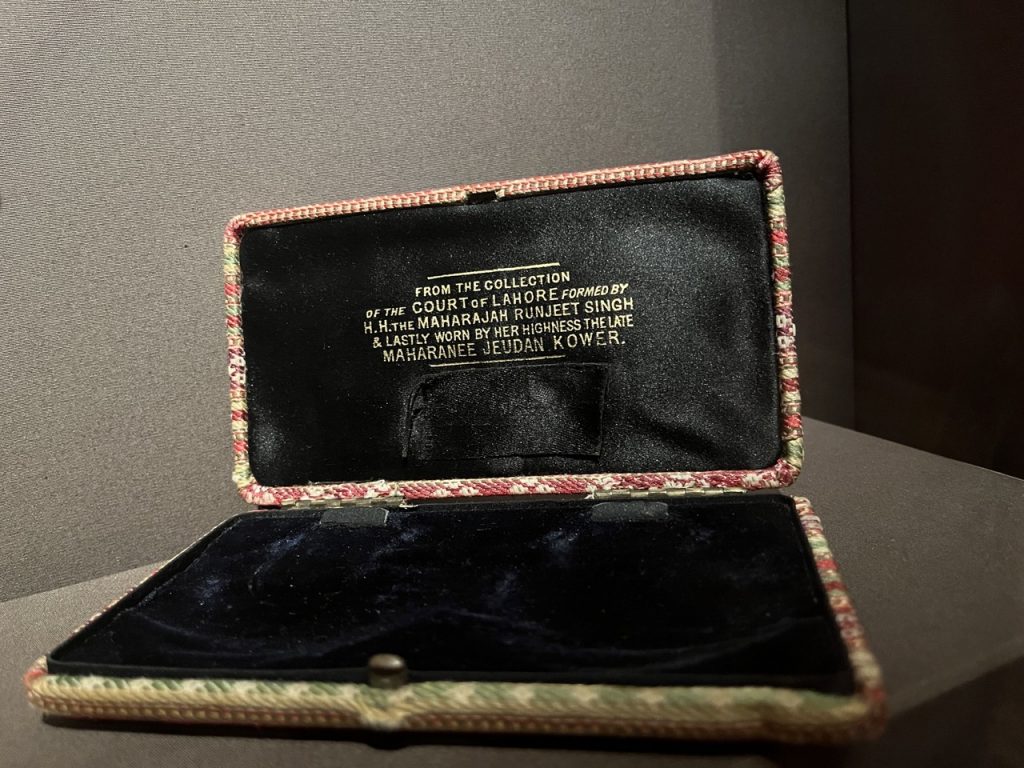
Empty case of one the about 1000 jewellery pieces impounded by the British after the annexation of Punjab
Koh-i-noor sketch & Satis of Maharajah Ranjit Singh
Ink wash water colour, simple sketches of Maharajah Ranjeet Singh’s prized jewels, including two views of Kohinoorfrom artist Frances Eden’s journal in the British Library are important exhibits. The hand written note on the left and the caption Kohinoor-the Sea of Light, sums it up.
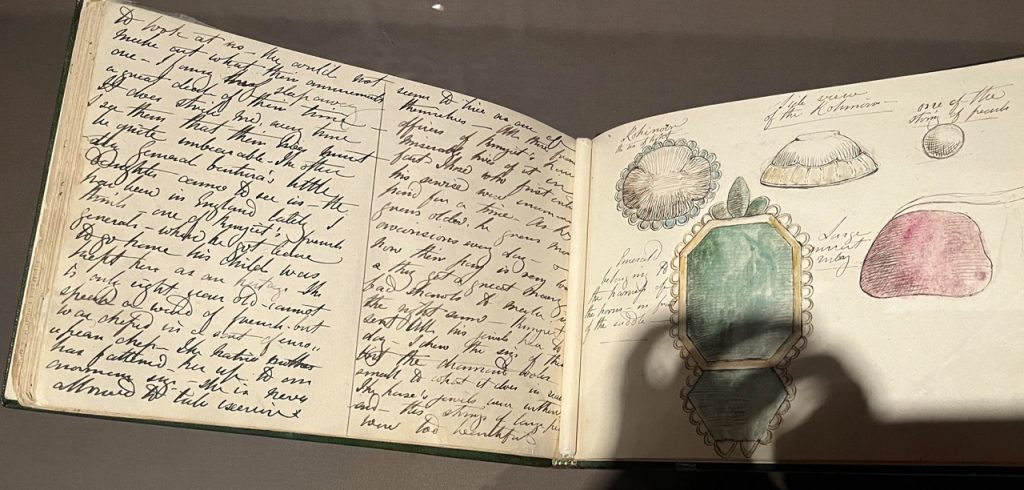
Sketches of Maharajah Ranjit Singh’s valuable jewels- from the journal of known artist Frances Eden including The Kohinoor
The Kangra-painting of Maharajah’s cremation- wrapped in a Kashmiri shawl, placed on a sandalwood funeral pyre and his 4 Rajput Queens with 7 maidservants; in an act of Sati – is an elegiac sad depiction that haunts one’s memory!! It is mentionable that the 3rd Sikh Guru Amar Das had condemned Sati in the 16th century but it was still practiced in the 19thcentury!
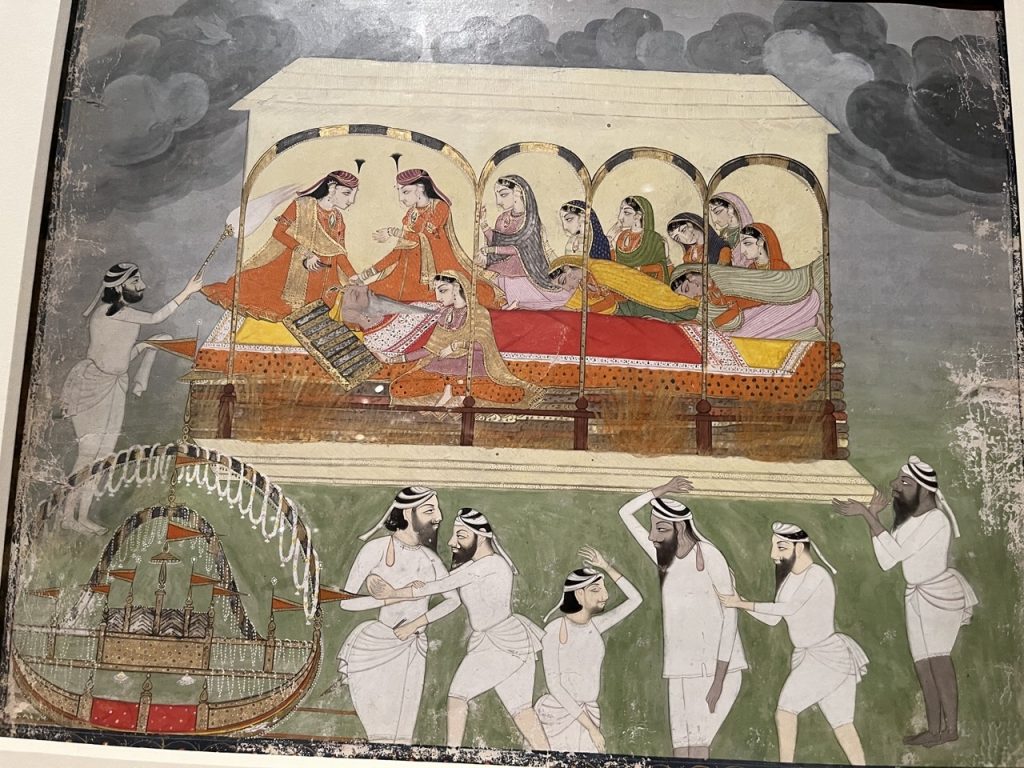
The Funeral of the Maharajah wrapped in a Kashmiri shawl with 4 Hindu Queens and 7 maids in an act of Sati
To be continued….
Watch out for Do You Know Facts in the next Part:
*Firangis – the formidable Generals in Maharajah’s army
*Unique Watercolours depicting secularism
*The Una Baba Sahib Singh Bedi ji & Kartarpur Baba Sadhu Singh Sodhi ji connexion with Maharajah Ranjit Singh ji
- Pair of Vambraces- battle arm covers of Maharajah Ranjit Singh ji- steel gold, velvet, sequins with silver thread
- 1 a The main Entrance of the Wallace- house Maharajah Ranjit Singh exhibition depicting his Lahore royal court partially- artist Bishan Sigh 1 Large
- Cuirass or Armour Breast plate-that bears a gold portrait of Guru Nanak in the centre etched with Gurmukhi scriptures for success & protection
- Pencil sketch of Maharani Jind Kaur 1863-mother Duleep Singh, proclaimed as Maharajah at the age of 5 but never was to be one!
- Sketches of Maharajah Ranjit Singh’s valuable jewels- from the journal of known artist Frances Eden including The Kohinoor
- The Funeral of the Maharajah wrapped in a Kashmiri shawl with 4 Hindu Queens and 7 maids in an act of Sati
- The gold embossed Golden throne sent to Britain after annexation of Punjab
- The magnificent Shamshir- the Tiger emblem sword of Maharajah Ranjeet Singh made of steel, gold copper, walrus ivory alonwith a cover of wood l
- The unique Turban Helmet( Taup) of Maharajah Ranjit Singh; to adjust the Sikh Turban, made of Steel gold, brass & velvet!
- Empty case of one the about 1000 jewellery piecesimpounded by the British after the annexation of Punjab
- Gold & steel gem-studded Shield of formidable warrior of Maharajah Ranjit Singh ji- Hari Singh Nalwa 1824
- Maharajah Ranjit Singhji with his formidable warrior Hari Singh Nalwa
- The finely embossed sheets of gold ornamentation by Hafiz Muhammad Multani ,1820-30 on the Golden Throne of Maharajah Ranjit Singh ji
- The Lahore Royal court of Maharajah Ranjeet Singh- impressive Gouache painting with gold & silver by artist Bishan Singh 1863-64
- The writer at the Exhibition- the Cuirass Gallery- Armour set of 4 Breast Plates
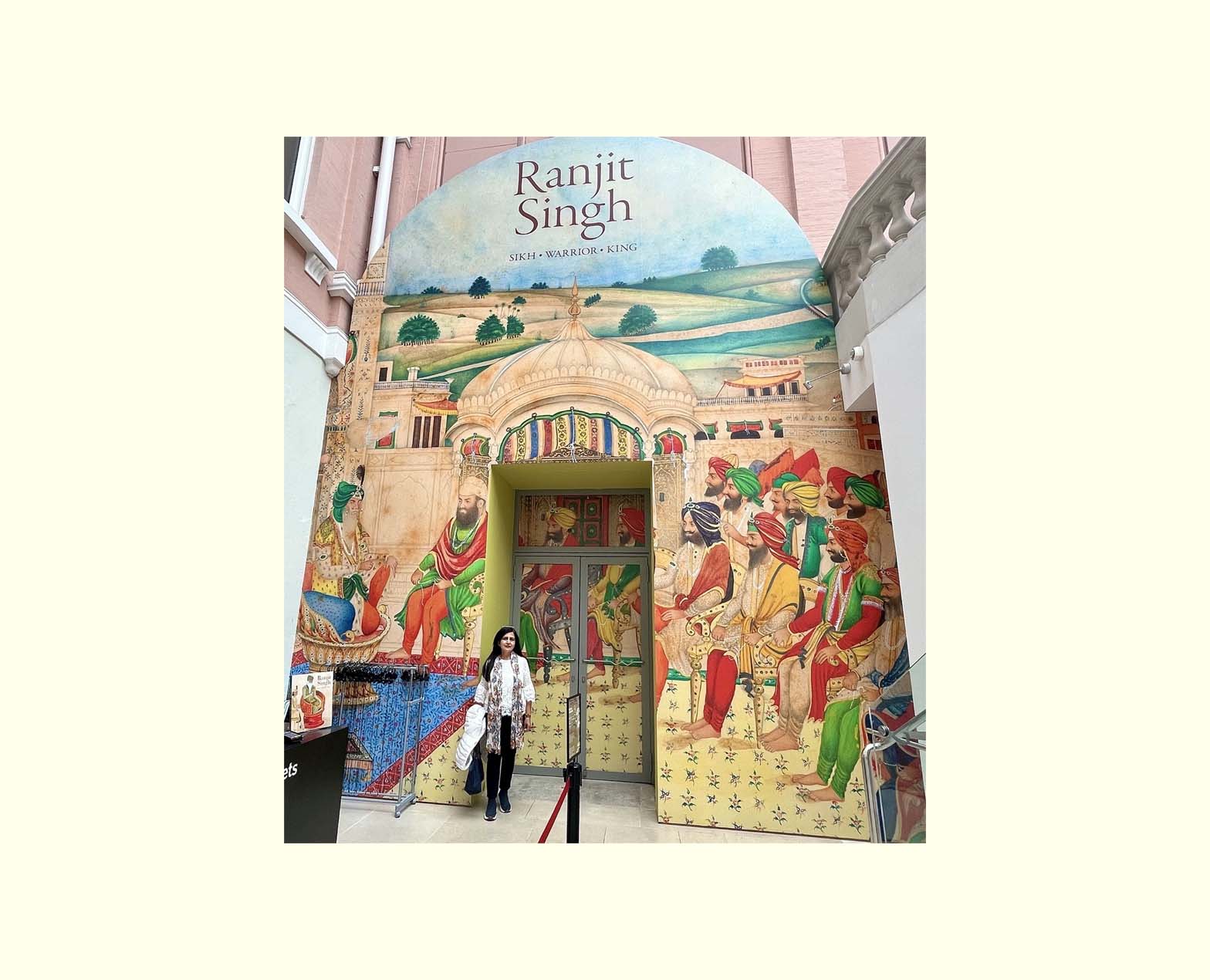
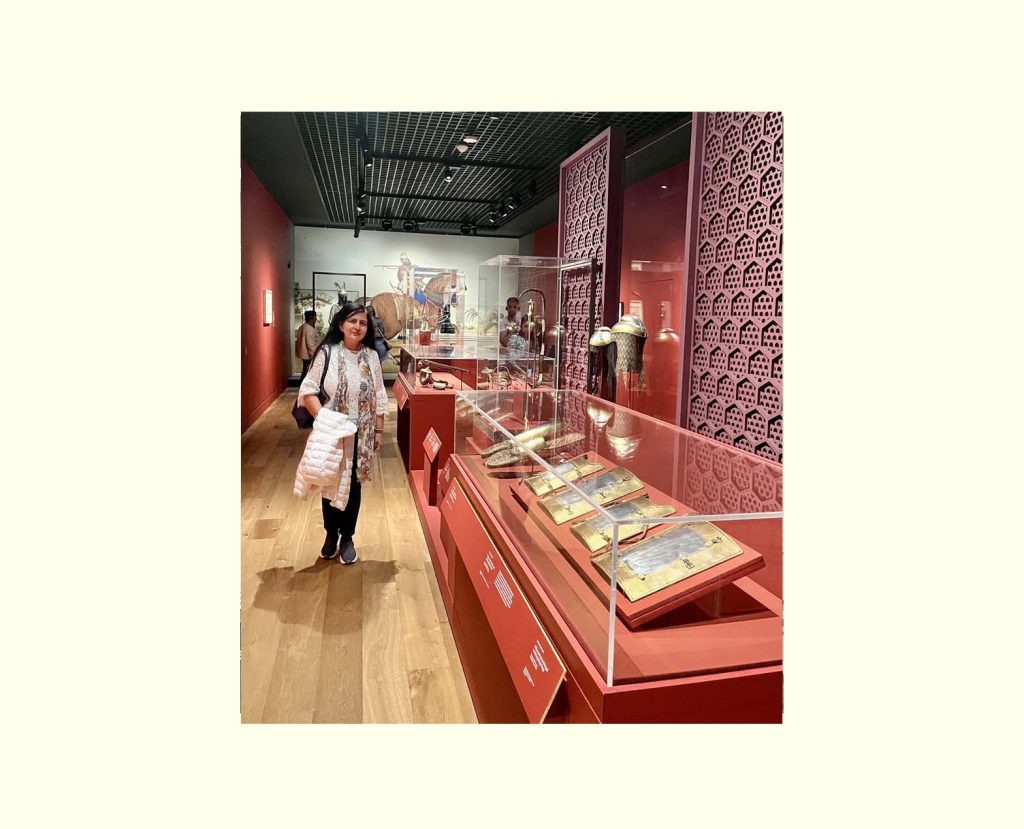
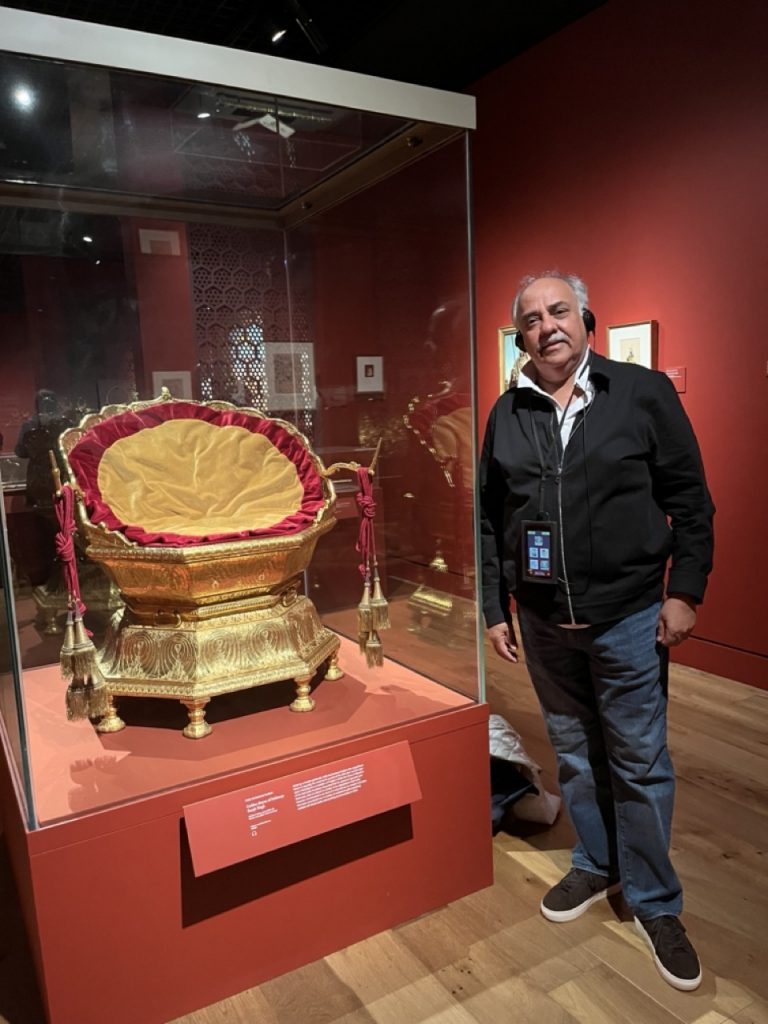
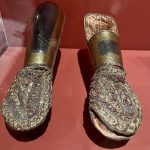

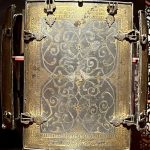
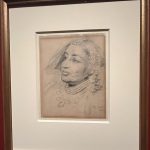
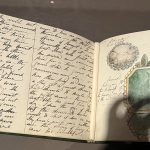
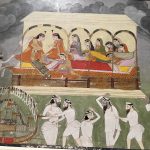
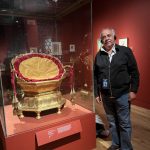
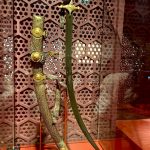
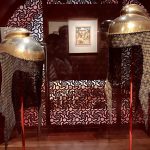
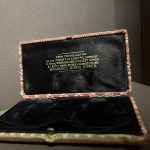
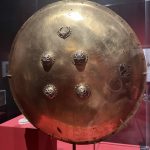
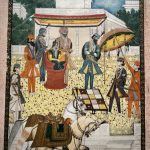
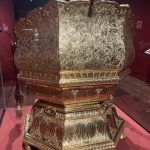
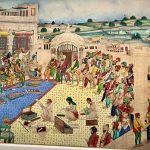
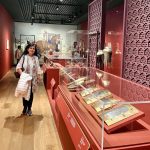
Beautifully written n thanks for telling n showing so many things and highlighting facts which we did not know of!
Great and amazing insight ..enjoyed going through the painting and different weapons 👌
It is beautifully worded Seema.You have given great information which people have forgotten especially the Indian government.The photography is excellent.
Great article on a great ruler of India of the pregone era. Look forward to such exhibitions being taken to all the large and medium sized cities of India to share the positive knowledge to motivate the youth of today and our country’s future.
Great work Seema. Look forward to more such work from you.
Seema ji, your article beautifully captures the grandeur and historical significance of Maharajah Ranjit Singh’s legacy, as displayed at the Wallace House. The vivid descriptions and stunning visuals truly bring to life the opulence and cultural richness of that era. Thank you for sharing this fascinating glimpse into such a magnificent exhibition.
Great insight into the life and times of Mahraja Ranjit Singh!
Our government must use diplomatic channels, at least, to bring back his throne.
A very well researched, detailed and beautiful pentatonic of ‘The Maharaja’. Loved this.
The article is a truly remarkable piece of writing, showcasing Seema ji’s incredible talent for weaving words with such depth and clarity. The way Seema ji has articulated the ideas and emotions is nothing short of extraordinary, making each sentence resonate with profound meaning. The insights offered are both thought-provoking and inspiring, reflecting a deep understanding of the subject matter. Seema ji’s ability to engage the reader and convey complex concepts in such an accessible and captivating manner deserves the highest praise. This is an article that not only informs but also leaves a lasting impact, and Seema ji’s skill and dedication are evident in every word. Beautifully written Mam.
Fantastic Read .
In depth & very interesting.
Why doesnt India ..Punjab do something Similar!!
This is an excellent and comprehensive depiction of this Sikh ruler who dominated the societal affairs of this region where five rivers flows contributing to the economic prosperity, literature, cultural and manifold influence over this piece of land that could easily called greater Punjab.